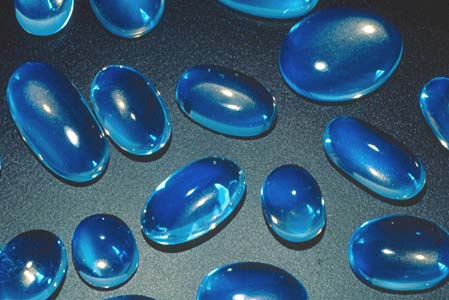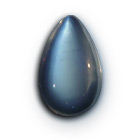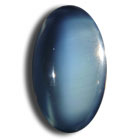 FREE SHIPPING on US orders over $150. Need help? Contact Us
FREE SHIPPING on US orders over $150. Need help? Contact Us Genuine Moonstone Gemstone

Moonstone
Moonstone shows an almost magical play of light as its characteristic feature. It owes its name to this mysterious gleaming which appears different whenever the stone changes its position in movement. Experts call this the “adularescence”, and in earlier times the phases of waxing and waning moon were though to be discerned in this phenomenon.
Moonstone from Sri Lanka, the classical country of origin for Moonstone, shimmers pale blue on almost transparent ground. Specimen from India shoe cloudlike plays of light and shade on beige brown, green, orange or simple brown background. These subdued colours in combination with the fine shine make Moonstone an ideal gemstone for jewellery with a sensuous and feminine character. This gemstone was once before extremely popular, about a hundred years ago in the times of Art Nouveau. It used to decorate a striking amount of pieces of jewellery created by the famous French Master Goldsmith René Lalique and by his contemporaries. These pieces are usually only found in a museum or in collections nowadays.
Many mystical and magical connotations surround this stone. In several cultures, like for example in India, it is considered a sacred and magical gemstone. In India Moonstone is also appreciated as a “dream stone”, as it is supposed to bring about sweet and beautiful dreams. In Arab countries women often were Moonstone sewn into their garment, because there this gemstone is appreciated as a symbol of fertility.
Moonstone symbolises a holistic view of man and woman. Its soft shine will support the emotional and dreamy tendencies of a person. The associations thus involved make Moonstone of course the ideal stone for lovers, reputed to bring forth feelings of tenderness and to protect true love. It is also reported that wearing a Moonstone will further intuition and your sensitivity for others.
 What are Moonstones and where do they come from?
What are Moonstones and where do they come from?
The mystical stone belongs to the large mineral family of feldspars, which provide almost two thirds of all stones on our Earth. In the case of Moonstone, we are looking at the feldspar variety called “adularia” a silicate of potassium aluminium in gemstone quality, which is also found in the European Alps near the Adula-group – thus the name “adularia”. Another synonym for Moonstone is “Selenite”, according to the Greek goddess of the moon, Selene.
When uncut, Moonstones look quite boring and make it difficult to discern their attractiveness: the mysterious play of light. It will only be brought out by the cutter’s expertise and skills. Classical Moonstones are always cut as cabochons. Here the appropriate height of the stone is essential. The cutter must also bear in mind to locate the crystal axis exactly in the zenith of the stone, because only then the desired effect of light play will be achieved.
The classical, bluish and almost transparent Moonstones traditionally came from Sri Lanka. But they are also found in the USA, in Brasil, Australia, Myanmar, and Madagascar. Since blue Moonstones in fine qualities have become more and more scarce in recent time, the prices have increased accordingly.
For some years now also green, blue and peach or smoke and champagne coloured, black and reddish specimen have been offered, which come mainly from India. Some of these show not only the typical the typical floating play of light, but also a cat’s eye or a multi-rayed star. These stones, then, are not only cut as cabochons, but also cut as intricate cameos, sometimes engraved as children’s -, moon - or gargoyle face. They also show the play of light which is so typical for Moonstone, just like the spheres and beads made from suitable raw material to be crafted into fine necklaces.
 Where does the striking play of light come from?
Where does the striking play of light come from?
The light of a Moonstone is something special indeed in the fascinating world of gemstones. Experts call this phenomenon “adularescence”. The origin of this phenomenon is the interior structure of the gemstone in scales or lamellas. Incoming rays of light are refracted inside the stone and scattered. In this way, then, there is created a unique play of light, which makes Moonstone so special and coveted.
This beautiful gemstone, however, has a considerable drawback: it only achieves a hardness of merely six on the Mohs’ scale. Moonstones should thus be handled carefully, as they are very fragile. On the other hand, small damages which will arise after longer periods of being worn, can be corrected relatively easily. A jeweller can have a dulled Moonstone polished in such a way, that it will regain its mystical light like on the first day.
Three-dimensional colour and seductive charm
When purchasing Moonstone you will be astonished at the striking differences in price. The more intense the colour, the larger and more transparent the stone, the more valuable is the gem. Really top quality fine blue Moonstone show an incredible “three-dimensional” depth of colour, which you will see clearly only when playfully tilting the stone and moving it. Such specimen are very rare and thus highly coveted, and of course accordingly valuable. The brighter coloured Indian Moonstones are not only a fashion trend. They are usually a little less expensive than the classical blue variant, so that everybody today may pick his or her favourite Moonstone to meet exactly all requirements of taste and budget.
Moonstones are Nature’s treasures with a sensuous and seductive charm. The do not only ask to be looked at and admired, the require to be worn and moved a lot. Because only then the soft veil of light which makes this gemstone so attractive will be able to display its beauty to the best effect.



